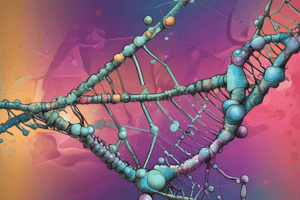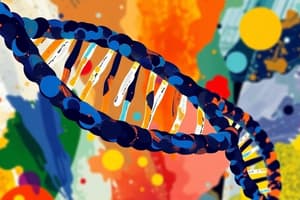Podcast
Questions and Answers
Under which condition will repressor mRNA be formed?
Under which condition will repressor mRNA be formed?
- In the presence of inducer
- Only when lac mRNA is absent
- Only in the presence of a specific substrate
- In the absence of inducer (correct)
What is the role of a probe in genetic fingerprinting?
What is the role of a probe in genetic fingerprinting?
- It is a radioactively labelled ds DNA
- It is a radioactively labelled ds RNA
- It is a radioactively labelled ss RNA
- It is a radioactively labelled ss DNA (correct)
What does the lac operon specifically code for?
What does the lac operon specifically code for?
- Proteins essential for amino acid synthesis
- Proteins involved in cell wall synthesis
- Regulatory proteins and enzymes critical for metabolism of lactose
- Repressor protein, permease, β-galactosidase, transacetylase (correct)
Which statement regarding the last peptide bond formation is correct?
Which statement regarding the last peptide bond formation is correct?
Which of the following pair of statements is correct regarding DNA polymorphism?
Which of the following pair of statements is correct regarding DNA polymorphism?
During translation, which of the following is true about the ribosome's movement?
During translation, which of the following is true about the ribosome's movement?
Which option correctly identifies the correct relationship between statements on polymorphism?
Which option correctly identifies the correct relationship between statements on polymorphism?
What occurs when an inducer is present in relation to repressor mRNA?
What occurs when an inducer is present in relation to repressor mRNA?
What type of gene arrangement occurs in the lac operon?
What type of gene arrangement occurs in the lac operon?
Which of the following statements regarding the operon is correct?
Which of the following statements regarding the operon is correct?
Which option correctly identifies the function of the proteins associated with the lac operon?
Which option correctly identifies the function of the proteins associated with the lac operon?
Which statement is true regarding the structural genes of the lac operon?
Which statement is true regarding the structural genes of the lac operon?
What is an example of a characteristic of repetitive DNA sequences?
What is an example of a characteristic of repetitive DNA sequences?
What does the 'Assertion (A)' state regarding repetitive sequences?
What does the 'Assertion (A)' state regarding repetitive sequences?
Regarding the structure of human genes, which statement is NOT true?
Regarding the structure of human genes, which statement is NOT true?
Which of the following matches Column I with Column II correctly?
Which of the following matches Column I with Column II correctly?
What is the main aim of the human genome project?
What is the main aim of the human genome project?
Which of the following statements about the lac operon is incorrect?
Which of the following statements about the lac operon is incorrect?
What determines the movement of DNA fragments during gel electrophoresis?
What determines the movement of DNA fragments during gel electrophoresis?
What was the probe used initially by Alec Jeffreys during the development of DNA fingerprinting?
What was the probe used initially by Alec Jeffreys during the development of DNA fingerprinting?
Which is the largest gene in the human genome?
Which is the largest gene in the human genome?
What is one of the goals of the human genome project?
What is one of the goals of the human genome project?
What occurs in the absence of lactose in relation to the lac operon?
What occurs in the absence of lactose in relation to the lac operon?
Which of the following criteria does NOT pertain to the movement of DNA fragments in gel electrophoresis?
Which of the following criteria does NOT pertain to the movement of DNA fragments in gel electrophoresis?
What marks the beginning of translation in the molecular process?
What marks the beginning of translation in the molecular process?
Which enzyme is responsible for the activation of amino acids during translation?
Which enzyme is responsible for the activation of amino acids during translation?
What is the process called when amino acids are linked to their cognate tRNA in the presence of ATP?
What is the process called when amino acids are linked to their cognate tRNA in the presence of ATP?
In the context of operon regulation, which of the following statements about Assertion (A) and Reason (R) is correct?
In the context of operon regulation, which of the following statements about Assertion (A) and Reason (R) is correct?
Which statement best describes the role of a repressor in operon regulation?
Which statement best describes the role of a repressor in operon regulation?
What is the essential function of the Lac operon in bacteria?
What is the essential function of the Lac operon in bacteria?
Which statement is false regarding peptide bond formation between two charged tRNAs?
Which statement is false regarding peptide bond formation between two charged tRNAs?
What is a common misconception regarding the activation of amino acids in protein synthesis?
What is a common misconception regarding the activation of amino acids in protein synthesis?
Flashcards
What enzyme activates amino acids for translation?
What enzyme activates amino acids for translation?
Amino acid activation is facilitated by aminoacyl tRNA synthetases, which are enzymes that catalyze the attachment of a specific amino acid to its corresponding tRNA molecule. This process is called aminoacylation or charging of tRNA, and it requires energy from ATP.
What event marks the beginning of translation?
What event marks the beginning of translation?
The initiation of translation begins when the small ribosomal subunit (30S) binds to the mRNA, followed by the binding of the initiator tRNA (carrying methionine) to the start codon (AUG) on the mRNA. This complex then recruits the large ribosomal subunit (50S) to form the complete ribosome. The process of translation is now ready to start.
How is the lac operon regulated?
How is the lac operon regulated?
The lac operon is a classic example of negative regulation, where a repressor protein inhibits the transcription of the operon's genes. This repression is relieved when a specific inducer molecule, like lactose, binds to the repressor, causing it to release the operator and allowing transcription to proceed. Thus, the presence of lactose allows for the production of enzymes needed to break it down.
What is charging or aminoacylation of tRNA?
What is charging or aminoacylation of tRNA?
Signup and view all the flashcards
What was the objective of the Human Genome Project?
What was the objective of the Human Genome Project?
Signup and view all the flashcards
What is DNA fingerprinting and what is it used for?
What is DNA fingerprinting and what is it used for?
Signup and view all the flashcards
What is a polycistronic structural gene?
What is a polycistronic structural gene?
Signup and view all the flashcards
What is an operon?
What is an operon?
Signup and view all the flashcards
What is the lac operon?
What is the lac operon?
Signup and view all the flashcards
What are repetitive DNA sequences?
What are repetitive DNA sequences?
Signup and view all the flashcards
What is Satellite DNA?
What is Satellite DNA?
Signup and view all the flashcards
What is the function of Satellite DNA?
What is the function of Satellite DNA?
Signup and view all the flashcards
What is bulk DNA?
What is bulk DNA?
Signup and view all the flashcards
What is the significance of bulk DNA and satellite DNA peaks?
What is the significance of bulk DNA and satellite DNA peaks?
Signup and view all the flashcards
Gel Electrophoresis
Gel Electrophoresis
Signup and view all the flashcards
DNA fingerprinting
DNA fingerprinting
Signup and view all the flashcards
Dystrophin gene
Dystrophin gene
Signup and view all the flashcards
VNTR (Variable Number Tandem Repeat)
VNTR (Variable Number Tandem Repeat)
Signup and view all the flashcards
Lac repressor protein
Lac repressor protein
Signup and view all the flashcards
Lac Z gene
Lac Z gene
Signup and view all the flashcards
Operator
Operator
Signup and view all the flashcards
Operon
Operon
Signup and view all the flashcards
What are the genes in the lac operon and their functions?
What are the genes in the lac operon and their functions?
Signup and view all the flashcards
Describe the movement of the ribosome during translation.
Describe the movement of the ribosome during translation.
Signup and view all the flashcards
What is the basis of DNA fingerprinting?
What is the basis of DNA fingerprinting?
Signup and view all the flashcards
What is a probe in DNA fingerprinting?
What is a probe in DNA fingerprinting?
Signup and view all the flashcards
What is polymorphism in relation to DNA fingerprinting?
What is polymorphism in relation to DNA fingerprinting?
Signup and view all the flashcards
Is polymorphism inheritable? How does that relate to DNA fingerprinting?
Is polymorphism inheritable? How does that relate to DNA fingerprinting?
Signup and view all the flashcards
Study Notes
Molecular Basis of Inheritance
-
Translation Initiation: Translation begins when the small ribosomal subunit encounters mRNA, not tRNA or the large subunit.
-
Amino Acid Activation: Aminoacyl tRNA synthetase, not RNA polymerase, methionine, or initiation factor, activates amino acids during translation.
-
Charging of tRNA: The process where amino acids are linked to their cognate tRNA in the presence of ATP is called aminoacylation or charging of tRNA.
-
Operon Regulation: Repressor-mediated regulation of an operon is considered negative regulation. Operons under activator control are positively regulated.
-
Lac Operon Enzymes: The enzymes of the lac operon are: β-galactosidase, permease, and transacetylase.
-
Human Genome Genes: The human genome contains approximately 2968 total genes and 231 genes are located on chromosome 1.
-
Human Genome Size: The human genome is approximately 2.4 million bases in length.
-
DNA Fingerprinting Probes: In genetic fingerprinting, radioactively labeled single-stranded DNA (ss DNA) probes are used.
-
Polymorphism and DNA Fingerprinting: DNA polymorphism is the basis of DNA fingerprinting and is an inheritable trait.
-
Human Genome Project Goal: The primary goal of the human genome project was to identify and sequence all human genes.
-
Genetic Fingerprinting Probe Mechanism: The accuracy of genetic fingerprinting is determined by a probe labeled with a radioactive signal, a double-stranded DNA.
-
Translation in Bacteria: During bacterial translation, the ribosome moves along the mRNA, linking amino acids to form a polypeptide, and the first amino acid isn't always proline. Last codon of mRNA is often CUU and the last peptide bond formation occurs between adjacent amino acids.
-
DNA Fragments Movement: In gel electrophoresis, smaller DNA fragments move faster and further than larger fragments. Therefore, the smaller the fragment size the farther the fragment moves.
-
Lac Operon Regulation: Galactose can bind and inactivate the repressor, the repressor binds to the operator in the absence of lactose which prevents transcription. The Z-gene codes for β-galactosidase
Studying That Suits You
Use AI to generate personalized quizzes and flashcards to suit your learning preferences.
Related Documents
Description
Test your knowledge on the molecular basis of inheritance with questions covering translation initiation, operon regulation, and key components of the human genome. This quiz will assess your understanding of crucial concepts such as amino acid activation and the lac operon.




